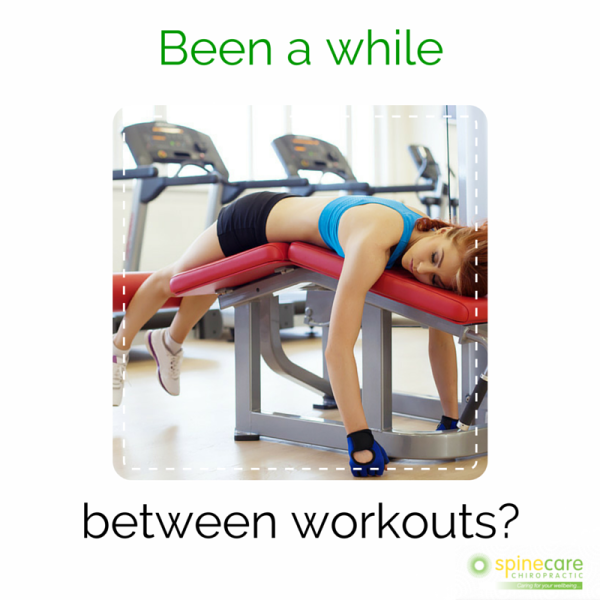Fallen off the fitness wagon?

Here are 5 easy ways to hop back on.
We’ve all been there.
Feeling guilty. Paralysed. Marveling at the spider webs in your sneakers. Has it really been that long between jogs?
Yep – we’re talking about falling off the fitness wagon.
One day you’re taut, terrific & training like a beast – the next, you’re horizontal on the couch.
Maybe you sustained an injury? Work got hectic. It was too cold to even contemplate morning exercise.
Whatever the reason, time passes quickly. And in a flash, three months fly by and you’re feeling more than a little sheepish.
But we’re here to help!
We wrote this article to give you a leg up back onto the wagon. To share our thoughts on how to reclaim your fitness safely, effortless & with zero guilt.
Sound good?
Read our top 5 tips for getting back into exercise.
The #1 rule is: banish guilt.
Harbouring guilt gets you nowhere. In fact, it undermines progress.
How? You hide from the problem, are less likely to tackle it thanks to the weight of self-criticism.
Guess what?
Sometimes it’s necessary to have a break, especially if you’re recovering from injury. Less is more. Restore function, enhance your body’s ability to cope with stress (exercise is a stressor, after all), THEN build up gradually.
Hey, you might have done yourself a favour!
And if you’ve simply embraced couch potato?
No sweat. (Literally, none).
Taking an extended break can restore mental focus & afford time to other pursuits: getting that work promotion, being there for your kids, moving house.
Sure, the goal is to make exercise a lifestyle mainstay – but if it’s been absent for a while, no stress. Look for the positives! Defuse the guilt. And get on with it!
Rule #2: know where your body’s at.
Understanding the changes that occur after an extended period of injury or inactivity helps foster self-compassion.
Two words: Muscle atrophy.
This is when your muscles get smaller, weaker & partially waste away. It happens over time due to disuse, disease or injury.
Whatever specifically applies to you, the principle remains the same: you won’t be able to run a half-marathon tomorrow or squat a Shetland Pony. Your muscles simply won’t allow it.
Which brings us to rule #3: Give yourself permission to work up slowly.
There will always be times of fitness and frailty; the trick is to accept them as normal facets of human existence.
Giving yourself permission to start small fosters calm perseverance instead of all-or-nothing, guns-blazing, short-lived motivation. Self-compassion is where it’s at.
Beginning with a 1km run or seriously light dumbbells might feel weak or pathetic, but try to suspend judgement.
Set yourself up to win!
Taking small, consistent steps is the best way to get anywhere – just ask Vincent Van Gogh:
‘Great things are not done by impulse, but by a series of small things brought together.’
Feeling mentally prepared? Good!
It’s time for rule #4: listen to your body.
As chiropractors, we often hear tales from members about what they’ve been recommended by other practitioners. Exercises that induced pain, fatigue or aggravation. We see this as working against, not with, the body. Ouch!
Our philosophy is to get function right first, THEN incorporate exercise. Otherwise, you defeat the purpose.
Even if you’re not recovering from a specific injury, an extended period of inactivity can lead to the kind of weakness that warrants care & incremental efforts (see above: muscle atrophy).
Listening to your body sounds nice in theory, but how do you do it in practice?
Ask the following questions:
- How do you feel before, during & after exercise?
- If you have an injury, is it aggravated?
- Do you feel energized after completing your workout, or fatigued?
If the answer to any of these questions is: it hurts! you need to do less. Stop at the point where you feel fatigue, pain or irritation and continue with the smallest amount of movement. Wait until you feel an improvement, then add more.
There’s nothing wrong with tiny slivers of exercise – in fact, you’re smarter for tuning in to your body’s needs.
Rule #5 is: support yourself with Chiropractic care.
Why?
Chiropractic care aims to improve the function of your body, ensuring you’re aligned and able to cope with the stress of exercise.
There’s no point working out if you’re going to aggravate an injury or deplete your energy reserves.
That’s why we recommend getting adjusted before embarking on your new exercise regime.
And here’s a cool trick:
Adjustments stimulate the same areas of the brain as exercise. After seeing your chiropractor, expect a flood of feel good hormones similar to that you enjoy post-workout.
This healthy stimulation of the nervous system is a big green light for your body to come back online.
Phew! We’ve worked up a sweat simply writing about fitness.
And now we hope you’re similarly inspired to start bringing movement back into your day. Slowly, safely & with oodles of self-compassion.
Remember to call or email us with any questions, feedback or fitness experiences. We’d love to hear from you!

